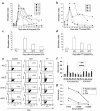Mature dendritic cells boost functionally superior CD8(+) T-cell in humans without foreign helper epitopes
- PMID: 10727452
- PMCID: PMC377466
- DOI: 10.1172/JCI9051
Mature dendritic cells boost functionally superior CD8(+) T-cell in humans without foreign helper epitopes
Abstract
We have recently shown that a single injection of mature, antigen-pulsed, human dendritic cells (DCs) rapidly elicits CD4(+) and CD8(+) T-cell immunity in vivo. The DCs were pulsed with 2 foreign proteins, keyhole limpet hemocyanin (KLH) and tetanus toxoid (TT), as well as an HLA A2.1-restricted influenza matrix peptide (MP). Responses to all 3 antigens peaked at 30-90 days after immunization and declined thereafter. To determine if the foreign helper proteins (TT and KLH) were essential for CD8(+) T-cell responses to the viral peptide, we reinjected 3 of the HLA-2.1 subjects with mature DCs pulsed with MP alone. All 3 volunteers showed a rapid boost in MP-specific immunity, and freshly sampled blood from 1 contained cytolytic T cells. In all 3 subjects, CD8(+) T-cell responses to booster DCs were faster and of greater magnitude than the responses to the first DC injection. Importantly, the T cells that proliferated after booster DC treatment secreted interferon-gamma upon challenge with much lower doses of viral peptide than those elicited after the first injection, indicating a higher functional avidity for the ligand. These data begin to outline the kinetics of T-cell immunity in response to DCs and demonstrate that booster injections of mature DCs enhance both qualitative and quantitative aspects of CD8(+) T-cell function in humans.
Figures



Comment in
-
Dendritic cells: at the clinical crossroads.J Clin Invest. 2000 Mar;105(6):707-8. doi: 10.1172/JCI9591. J Clin Invest. 2000. PMID: 10727437 Free PMC article. No abstract available.
-
How much help does a vaccine-induced T-cell response need?J Clin Invest. 2001 Mar;107(5):553-4. doi: 10.1172/JCI12403. J Clin Invest. 2001. PMID: 11238555 Free PMC article. No abstract available.
References
-
- Raychaudhuri S, Rock KL. Fully mobilizing host defense: building better vaccines. Nat Biotechnol. 1998;16:1025–1031. - PubMed
-
- Banchereau J, Steinman RM. Dendritic cells and the control of immunity. Nature. 1998;392:245–252. - PubMed
-
- Murphy G, Tjoa B, Ragde H, Kenny G, Boynton A. Phase I clinical trial: T-cell therapy for prostate cancer using autologous dendritic cells pulsed with HLA-A020-specific peptides from prostate-specific peptides from prostate-specific membrane antigen. Prostate. 1996;29:371–380. - PubMed
-
- Nestle FO, et al. Vaccination of melanoma patients with peptide- or tumor lysate-pulsed dendritic cells. Nat Med. 1998;4:328–332. - PubMed
Publication types
MeSH terms
Substances
Grants and funding
LinkOut - more resources
Full Text Sources
Other Literature Sources
Medical
Research Materials

